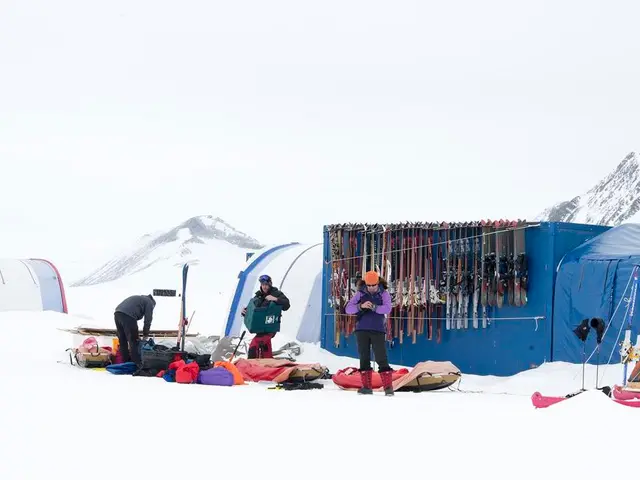Essential Health Strategies for High-Altitude Areas: Crucial Medical Preparation Tips
Traveling to high-altitude destinations can be an exhilarating experience, but it's essential to take precautions to ensure a safe and enjoyable journey. Here's a comprehensive guide on preventing and managing altitude sickness.
## Prevention Strategies
1. **Gradual Ascent**: Ascend slowly, allowing your body to acclimatize. Aim for no more than 1,000 feet (300 meters) of elevation gain per day once above 8,000 feet (2,400 meters)[1][2].
2. **Flexible Itinerary**: Plan extra days for acclimatization, especially if you're traveling to very high altitudes. For instance, if you're visiting Cusco, Peru, spend a few days there before proceeding to higher elevations like the Inca Trail[2].
3. **Hydration and Rest**: Drink plenty of water (3 to 4 liters per day) and limit physical exertion during the initial days at high altitude[1][3]. Rest is crucial, especially during the first 24 hours.
4. **Avoid Alcohol and Sedatives**: Both alcohol and sedatives can exacerbate altitude sickness by depressing respiration[1].
5. **Medications**: Consult your doctor about taking **Acetazolamide (Diamox)**, which can help increase acclimatization rates. Other medications like **Promethazine** for nausea and **Paracetamol** or **Ibuprofen** for headaches may also be prescribed[2][3].
6. **Climb High, Sleep Low**: If possible, climb to higher elevations during the day but return to a lower altitude to sleep[1].
7. **Stay Sun-Safe**: Use sunscreen with an SPF of at least 30, as UV exposure increases at higher elevations[4].
8. **Maintain a Balanced Diet**: Incorporate complex carbohydrates (around 70% of total caloric intake) into your diet to enhance oxygen delivery to muscles and improve energy levels at elevation[5].
9. **Supplementation**: Sodium, potassium, and magnesium supplementation can help maintain muscle function and prevent cramping at high altitudes[6].
10. **Vaccinations**: Consult a healthcare provider for vaccinations and prophylactic medications pertinent to your itinerary, especially if traveling to regions in North Africa or Greece[7].
## Management of Symptoms
1. **Monitor Symptoms**: Watch for signs of altitude sickness, such as headaches, nausea, or insomnia. If symptoms persist or worsen, descend to a lower altitude[4].
2. **Use Oxygen**: In severe cases, oxygen therapy may be necessary. However, this should be done under medical supervision[4].
3. **Descend**: If symptoms are severe or do not improve with rest and hydration, descend immediately to a lower altitude[8].
By following these guidelines, you can significantly reduce the risk of altitude sickness and ensure a safer and more enjoyable trip to high-altitude destinations. Remember, proper planning and preparation are key to a successful high-altitude adventure.
[1] Prior to departure, consult with a medical professional regarding any necessary vaccinations or prophylactics based on the destination. [2] Gradual ascent is essential for successful acclimatization, aiming for no more than 1,000 feet (300 meters) of elevation gain per day once above 8,000 feet (2,400 meters). [3] Maintaining adequate hydration is crucial at high altitudes; aim for a daily intake of 3-4 liters of water. [4] Use sunscreen with an SPF of at least 30, as UV exposure increases at higher elevations. [5] Incorporating complex carbohydrates (around 70% of total caloric intake) into your diet can enhance oxygen delivery to muscles and improve energy levels at elevation. [6] Sodium, potassium, and magnesium supplementation can help maintain muscle function and prevent cramping at high altitudes. [7] Consult a healthcare provider for vaccinations and prophylactic medications pertinent to your itinerary, especially if traveling to regions in North Africa or Greece. [8] Early signs of AMS include headache, fatigue, and dizziness. If symptoms worsen, descending to lower altitudes (at least 500-1,000 meters) is vital for recovery.
- Maintaining a healthy lifestyle, which includes regular fitness and exercise, mental health care, skin care, and eye health, can contribute to better resistance against the effects of altitude sickness.
- Incorporating chronic disease management and respiratory condition management into your travel plans is crucial, as high altitudes can exacerbate these conditions.
- Science also plays a significant role in understanding the effects of aging on the body at high altitudes, helping to develop strategies for acclimatization.
- For travelers focusing on health and wellness, it's important to consider the impact of altitude on sleep patterns and to take measures to ensure restful sleep during the journey.
- As you plan your travel itinerary, ensure you include time for health checks and necessary medical-condition assessments to gain a complete understanding of your body's readiness for high-altitude destinations.
- Lastly, remember that lifestyle choices, such as maintaining a balanced diet and staying sun-safe, are essential components of a successful and enjoyable high-altitude adventure.




